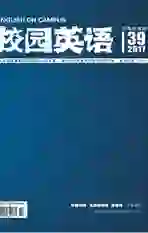AnAnalysisoftheRhymeSchemeofthePoemStoppingbyWoodsonaSnowyEvening
2017-12-27刘娜
刘娜
【Abstract】This paper attempts to study the poem Stopping by Woods on a Snowy Evening written by a famous American poet Robert Frost through analyzing the rhyme scheme and and the two sounds that occur frequently in the poem which contribute to the strengthening of the conflict feelings of protagonist of the poem.
【Key words】Rhyme scheme; Conflicting feelings
In stylistic, sound -like alliteration, assonance and consonance in poetry-always brings special effects. Every word has a sound as well as a meaning. We perhaps do not pay much attention to the sounds that words make in our daily communication. But in poetry, sounds, as a special ways of expressing, are employed to play an important part in the impact of a poetry. Unlike the man who uses language only to convey information, a great poet, however, will carefully and repeatedly choose the right or the best words for sounds as well as for meanings. And then uses the sounds as a way to reinforce his meaning.
The poem Stopping by Woods on a Snowy Evening uses traditional foot rhyme and stanzas to show a strong sense of rhyme. The poem is composed of four stanzas and there are four lines in each stanza. The rhyme scheme of the poem is aaba, bbcb, ccdc, dddd. Every stanza has the same foot rhyme except for the third line in each stanza and the foot rhymes are /o/, /ir/, /eik/, and /i:p/ except for the third lines accordingly. While, there is one point that we should pay attention to, that is, the foot rhyme of the next stanza is always the same as the foot rhyme of the third line in the last stanza, for instance, queer /ir/, near /ir/ and year /ir/ in the second stanza is the same as here /ir/ in the third line of the first stanza. And similarly, the third stanza follows the same rule. But the last stanza uses the same foot rhyme /i:p/. The rhyme scheme not only shows the beauty of the poem concerning the rhyme but also presents readers the struggle of the author. As is presented in the appendix, the foot rhyme of the poem is not exactly the same in the first three stanzas but changes into completely the same in the last stanza. Together with the former analysis, we can conclude that the change of foot rhyme from unstable to stable shows the mans inner thought from struggling to tranquil. The traveler was at first in contradiction about whether to fulfill his duty in life or not, fortunately, he finally made it clear that even though there are hardships and miseries in real life, it will be overcame and problems will be solved.endprint
There are two sounds /s/ and /w/ that occur several times in the poem. According to stylistic, we have known that the sound that a word makes conveys some meaning. In the poem, /s/ is a sound that occurs twenty-one times in the poem, which gives readers the impression of a raining or snowing day. It serves as a foil to the silent and tranquil snowy evening. The other sound /w/ appears eleven times in the poem, which would make readers feel the sound of the wind. This sound add another characteristics of the snowy evening-an evening with a howling wind.All these two sounds are employed to illuminate the atmosphere, a quite evening when the man pondering on his life.
In conclusion, both the foot rhymes and the certain sounds in the poem contribute to the theme of the poem:the mans struggle and finally makes up his mind to bear his responsibilities in real life.
References:
[1]Chang Lang.Stylistic Analysis of Stopping by Woods on a Snowy Evening[J].Journal of Yanan University(social science).2007,(3).
[2]Li Zhengshuan.Studies on American Poetry.Beijing:Peking University Press,2007.endprint
